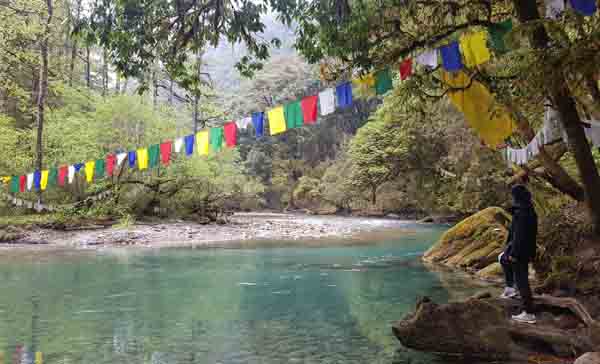- Jigme Dorji National Park
- Wangchuk Centennial Park
- Bumdeling Wildlife Sanctuary
- Phibsoo Wildlife Sanctuary
- Thrumsingla National Park
- Jigme Singye National Park
- Sakteng Wildlife National Park
- Jigme Singye Wangchuck National Park also popularly called as Black Mountains National Park
- Toorsa Strict Nature Reserve
- Khaling Wildlife Sanctuary
- Royal Manas National Park

1. Royal Manas Bhutan
An unparalleled biological treasure in the Eastern Himalayas, Royal Manas National Park (RMNP) represents the largest example of tropical and sub-tropical ecosystems in Bhutan. With hundreds of wildlife, birds and plant species, several globally endangered, Royal Manas is not only the most diverse protected area in the Kingdom but also one of the world’s biologically outstanding conservation sites. The park is the fourth largest national park in Bhutan with an area of 1057 km2 and covers the three districts of Sarpang, Zhemgang and Pemagatsel. The park area begins from the plains of Manas River in Bhramaputra basin at 108 meters and extends up to 2600 meters above sea level. After being maintained as a forest reserve by the Royal Government of Bhutan for many years, Royal Manas was notified as a wildlife sanctuary in 1964, making this park, the nation’s oldest protected area. In 1993 the area was upgraded to a national park. Now, it forms part of the Bhutan Biological Conservation Complex, an extensive system of protected areas and biological corridors covering over 50 percent of the country Royal Manas is linked to Jigme Singye Wangchuck National Park to the north and India’s Manas Tiger Reserve in the south. The park is also linked to Phibsoo Wildlife Sanctuary and Thrumshingla National Park through biological corridors. The principal reason for this linkage is to provide a continuous gradation of protected natural habitats from tropical duars all the way to alpine Himalayan highlands. This initiative is without doubt a unique conservation achievement in the Himalayas. Today this largely unexplored treasure is opened to tourists to promote community based ecotourism in the park.
It is considered auspicious to visit this place from the eighth month of the Bhutanese calendar until the twelfth month. It is believed that one should dip for at least three continuous days to get the full effect of the minerals in the waters.

2. Jigme Singye National Park
Jigme Singye Wangchuck National Park (JSWNP) is endowed with large areas of natural ecosystems. Unlike other national parks around the world, JSWNP is also a home to several cultural rich agricultural villages . You can get the glimpse of Jigme Singye Wangchuk Park by venturing into Nabji-Korphu trek.

3. Jigme Dorji National Park
Jigme Dorji National Park - the second largest park; and it’s overwhelmed with nature’s surprises and magnificence. Therefore, it is home for some of the world’s rarest animals and plants. Beside the national animal- takin, the national bird- raven, the national tree- cypress, some endangered animals like snow leopard, blue sheep and red panda roam freely without much interference from humankind.

4. Thrumshingla-National-Park
Thrumshingla National Park is a jewel within the protected area system of Bhutan. It has huge expanses of some of the last remaining stands of cool-temperate broad-leaved forests and old fir growth in the entire Himalayas. The park has a combination of all the different vegetation zones of Bhutan. A record of 360 bird species in the park includes globally threatened rufous-necked hornbill, beautiful nuthatch, Pallas’ fish eagle, chestnut breasted partridge, and other rare species like yellow-rumped honeyguide, ward’s Tragon, and Tawny Fish Owl. The park has 69 species of mammals. The Royal Bengal Tiger has been recorded as high as 2,950 meters above sea level, and the Red Panda is frequently sighted along the national highway. The other mammal species such as Himalayan Black Bear, Common Leopard, and Musk Deer are commonly sighted. More than 622 plant species are found in TNP, comprising 152 medicinal plants and 21 species endemic to Bhutan. Atop the high pass, there is an in-situ rhododendron garden with 22 species of flower, and over 50 species of edible mushrooms from the wild can be sighted.

5. Sakten Wildlife Sanctuary
Established in 2003, the Sakten Wildlife Sanctuary (SWS), covering an area of 740 square km between 1,800- 4,400 meters is possibly the world’s only protected area known to harbor the highly reclusive yeti (snowman). Locate in the easternmost part of the county in Tashigang, SWS is designed to protect the country’s eastern-most temperate ecosystem which harbor, among others, endemic species such as the eastern blue pine and black-rumped magpie. The forest contains 203 tree species. The sanctuary is also famous for faunal diversity. There are 18 species of mammals and 147 species of birds. The park area covers both Merak and Sakten and a part of Lauri geowg in Samdrup Jongkhar Dzongkhag. The sanctuary is connected to the Khaling Wildlife Sanctuary in the south part of the country by a biological corridor that is part of the Bhutan Biological Conservation Complex. The SWS and the corridors linking the sanctuary to the Khaling Wildlife Sanctuary are home to the headwaters of three major rivers of Manas, Bada, and Dhansiri.

6. Bumdeling Wildlife Sanctuary
Covering an area of 1520 square km, the Bumdeling Wildlife Sanctuary (BWS) contains a wealth of flora and fauna, including some of the most scenic alpine lakes in Bhutan. The park was created out of a need for the protection of the full range of natural ecosystems found between the Indian plains and the high Himalayas, specifically in the temperate zone. Located at an elevation of 1,500- 6,00 meters, the sanctuary is one o the country’s two winter roosting spots for the Black Necked Cranes. The park shares ecosystem buffer zones with part of Trashiyangtse, Lhuntshe, and Mongar Dzongkhags, and international borders with China in the north and the Indian state of Arunachal Pradesh in the northeast. The three main rivers in the park are Kulong Chhu in the east, Khoma Chhu in the west, and Sheri Chhu in the south.
